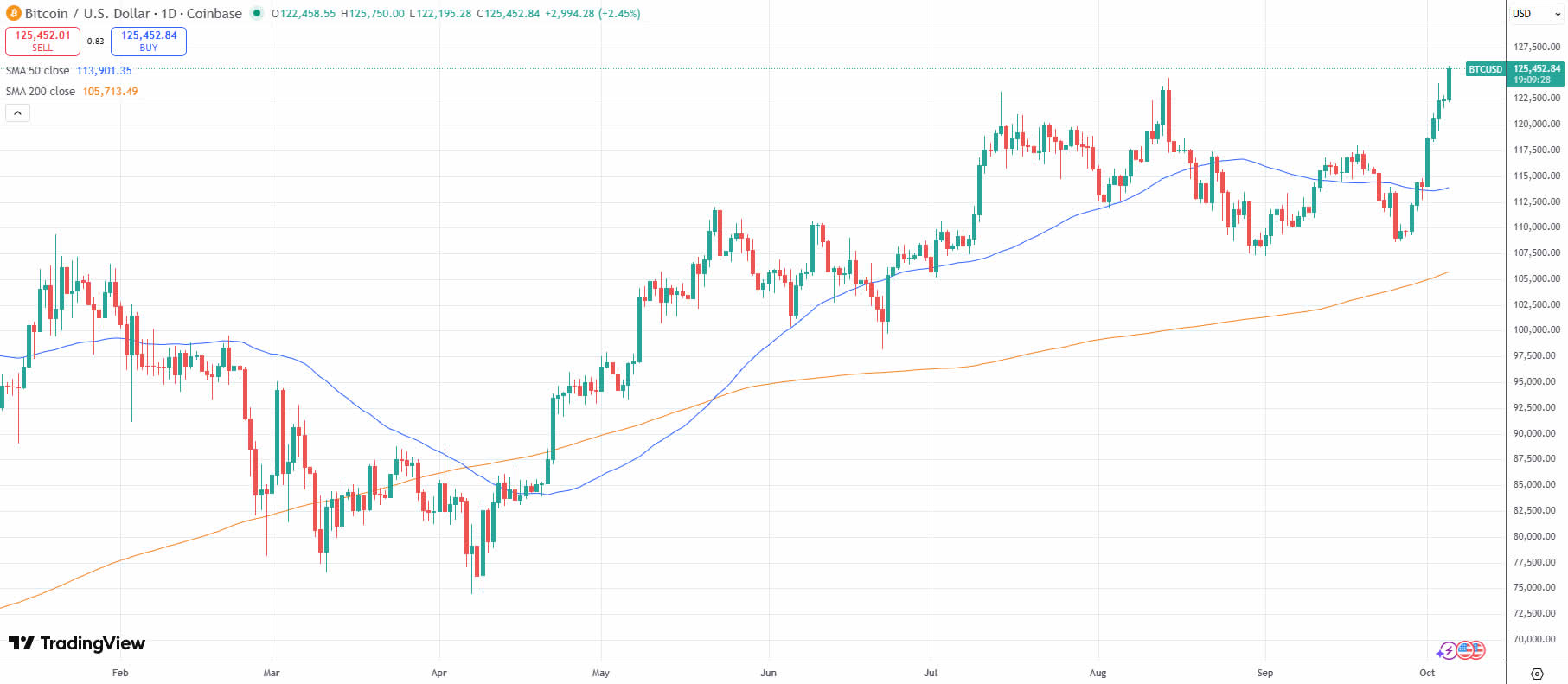Bitcoin has hit a historic milestone, breaking through the $125,000 mark for the first time to cement its position as the world’s most valuable and closely watched digital asset. The surge, which saw prices climb a little over $125,700 on Coinbase on Sunday morning, marks another high point in what has been a remarkable year for cryptocurrency markets.
The rally, which powered past its previous peak and all-time high at $124,500 on 14 August 2025, has been driven by several factors: a weakening U.S. dollar, deepening institutional adoption, and a notable shift in political sentiment in Washington.
Nigel Green, CEO and founder of the global financial advisory firm deVere Group, believes this momentum is far from over, but “Uptober” has only begun. He predicts Bitcoin could climb to $150,000 before the end of the year, a target that once seemed unthinkable but now feels within reach.
Green attributes Bitcoin’s ascent to fundamental market changes rather than short-term speculation. “The price action reflects a deeper structural change in how investors view digital assets,” he said.
“Bitcoin is no longer a speculative corner of the market; it’s being treated as a legitimate macro instrument. Institutional capital, treasury allocations, and sovereign interest are reshaping the market’s depth and maturity.”

This sentiment reflects the growing acceptance of BTC as a credible asset class. Institutional inflows have spiked sharply since mid-year, supported by expanding exchange-traded fund (ETF) volumes and rising allocations from corporate treasuries. Major asset managers now treat the digital gold as both a portfolio diversifier and a hedge against macroeconomic uncertainty.
Market data shows daily trading volumes surpassing $50 billion, with the latest rally forcing the liquidation of more than $200 million in short positions. Analysts say the surge underscores how the coin has evolved from a niche investment into a central component of global capital markets.
Despite intermittent pullbacks, Green insists volatility is a natural part of the process. “Volatility is a feature of price discovery, not a flaw,” he explained. “Short-term corrections are part of a healthy market dynamic, especially in a phase of expansion like this.”
A weaker dollar fuels Bitcoin’s strength
The timing of Bitcoin’s record-breaking move coincides with renewed weakness in the U.S. dollar. The greenback has fallen to multi-week lows against major currencies amid growing uncertainty surrounding U.S. fiscal policy.
This decline has revived Bitcoin’s appeal as an alternative store of value, particularly among investors looking to hedge against inflation, currency depreciation, and fiscal instability.
“Decentralised, borderless assets become more valuable every time the dollar weakens or government data delays,” stated Green. “Bitcoin’s appeal strengthens when trust in central authority is questioned, and right now, that trust is under heavy strain.”
This narrative has resonated strongly across global markets. From Asian family offices to European hedge funds, the search for alternative assets has intensified as traditional instruments struggle to deliver returns. Bitcoin’s digital scarcity, combined with growing acceptance by policymakers, has given it a unique position at the intersection of innovation and macroeconomics.


Another key driver behind Bitcoin’s rally has been political. The digital asset industry received a boost earlier this year when President Donald Trump reaffirmed his administration’s commitment to keeping the U.S. at the forefront of blockchain and crypto innovation.
“Policy matters,” Green explained. “When the administration signals openness to innovation, it catalyses institutional confidence. This policy tailwind, coupled with clearer regulatory direction, is propelling Bitcoin into the mainstream of portfolio strategy.”
Under the new framework, regulators have adopted a more transparent approach toward digital asset oversight, offering guidance to both exchanges and investors. This has encouraged large institutions to increase exposure, viewing Bitcoin not as a regulatory risk but as an asset class with defined parameters.
The improved policy climate, combined with a surge in ETF activity, has helped BTC mirror the optimism of broader risk assets while maintaining its reputation as a safe-haven hedge. This dual identity, part growth asset, part digital gold, has widened its investor base and strengthened its resilience.
Also read: How Nigeria plans to tax crypto holders and traders from January 2026
As Bitcoin scales new heights, its investor profile continues to evolve. Large asset managers, corporate treasuries, and even governments are integrating Bitcoin into their strategic frameworks.
“The current cycle is defined by integration, not speculation,” Green noted.
“Large asset managers, corporates, and even governments are incorporating Bitcoin into their frameworks for diversification and strategic reserve management. The breadth of adoption is what gives this rally staying power,” he added.
This institutional integration is also reflected in price behaviour. While some traders have taken profits at record levels, each dip has found higher support, a sign of deepening market conviction.
“That pattern tells us the market is being underpinned by conviction capital rather than short-term bets,” Green said. “The accumulation trend among institutions and high-net-worth investors remains strong.”


As Bitcoin continues to move into the mainstream, its role within the global financial system is becoming more entrenched. Once dismissed as speculative, it is now discussed in the same breath as traditional macro hedges like gold or inflation-linked bonds.
The road to $150k mark
Looking ahead, Green believes Bitcoin’s trajectory remains firmly upward. “We’re in a phase where digital assets are integral to the global financial system,” he said. “Bitcoin’s limited supply and growing integration make it an essential hedge in a world of mounting fiscal pressure and currency depreciation.”
If current trends persist, with institutional demand rising, the dollar weakening, and political sentiment remaining supportive, deVere’s projection of $150,000 by year-end could prove conservative.
The broader implication is that Bitcoin is no longer a speculative outlier. It has evolved into a financial instrument that reflects deeper shifts in global trust, policy, and technology. As macroeconomic headwinds continue and the appetite for decentralised assets grows, Bitcoin’s next chapter appears poised to redefine how the world perceives value itself.








